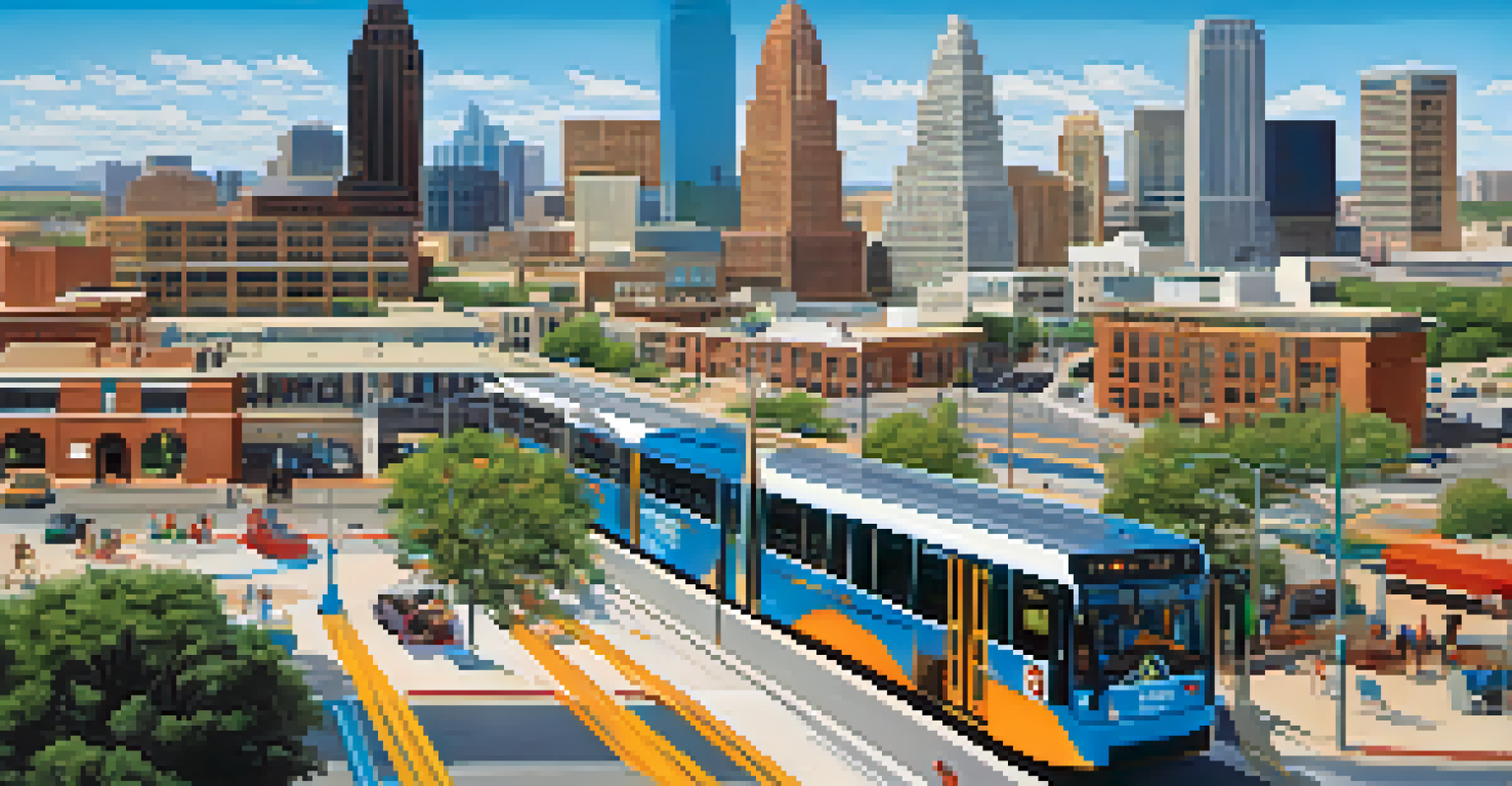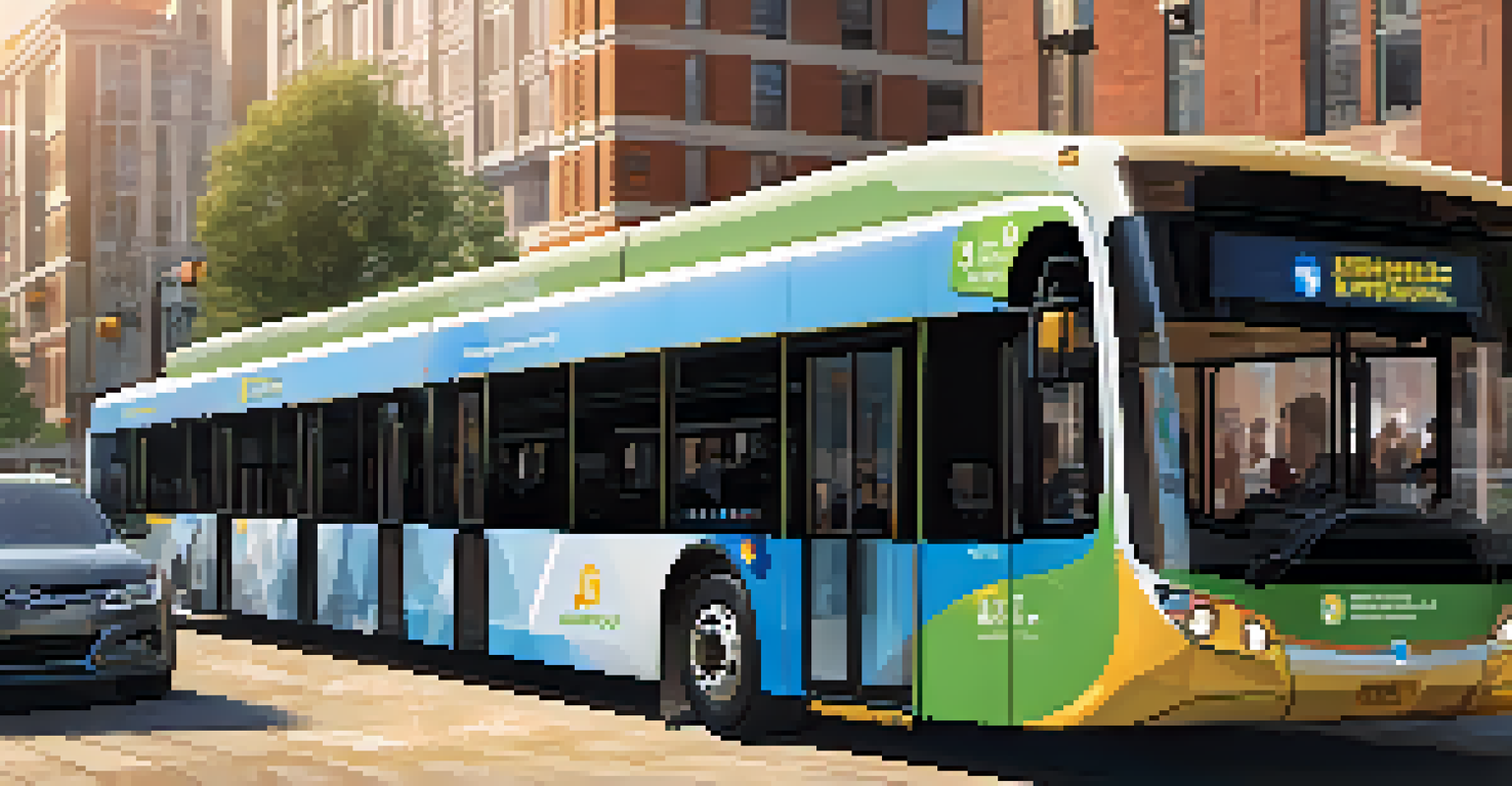Comparing Austin's Public Transportation to Other Major Cities

Overview of Austin's Public Transportation System
Austin's public transportation system, known as Capital Metro, includes buses, MetroRapid, and a light rail service. Established to cater to the growing population, the system aims to provide efficient transportation options to residents and visitors alike. However, it faces challenges like limited routes and frequency, especially compared to larger cities.
Public transportation is a lifeline for urban communities, providing affordable mobility and reducing our carbon footprint.
In recent years, Austin has made strides to enhance its public transit infrastructure, including the implementation of electric buses and expanded service hours. Yet, it still lags behind cities like New York or San Francisco, where public transportation is more integral to daily commutes. This discrepancy often leads to discussions about the future direction of Austin's transit developments.
Ultimately, understanding Austin's public transportation system is essential for evaluating its effectiveness and how it meets the needs of a rapidly growing urban population. As we dive into comparisons with other major cities, we can better appreciate both the strengths and weaknesses of Austin's transit offerings.
Public Transportation Options in Major Cities
Cities like New York, Chicago, and Los Angeles offer extensive public transportation networks, often including subways, buses, and trams. For instance, New York's MTA serves over 5 million riders daily, making it one of the busiest systems in the world. Such scale allows for greater accessibility and convenience for residents, reducing reliance on personal vehicles.

In contrast, Austin’s Capital Metro serves around 100,000 daily riders, a fraction of New York’s volume. While Austin's system has its merits, like affordability and a focus on sustainability, it simply cannot match the breadth and depth of larger urban centers. This comparison highlights the impact of population density on public transit effectiveness.
Austin's Transit System Needs Improvement
Despite recent enhancements, Austin's public transportation still struggles with limited routes, frequency, and coverage compared to larger cities.
Moreover, cities like San Francisco utilize their iconic cable cars alongside an expansive subway system, presenting a unique blend of historical and modern transport options. This diversity not only attracts tourists but also enhances the overall commuting experience for locals, a feature that Austin is still working to develop.
Accessibility and Coverage in Austin vs. Other Cities
Accessibility is a critical factor when evaluating public transportation systems. In Austin, while many neighborhoods are served by bus routes, some areas, especially those further from the city center, lack adequate coverage. This can make commuting a challenge for residents outside of the core urban areas.
A city's public transit system is only as good as its ability to connect people to their daily lives.
In contrast, cities like Boston or Washington, D.C. have extensive networks that reach out to suburban areas, making public transportation a viable option for a more significant portion of the population. This broader reach encourages public transit use, ultimately reducing traffic congestion and pollution in urban centers.
Austin has been working to improve accessibility through initiatives like the Community Engagement Program, aimed at identifying gaps in service. However, until more comprehensive solutions are implemented, it remains a challenge for many residents relying on public transit for daily commutes.
Frequency and Reliability of Public Transport Services
Frequency and reliability are essential aspects of any public transportation system. In cities like Chicago, trains run every few minutes, allowing commuters to plan their travel with ease. This level of service encourages more people to opt for public transport over driving.
Austin's public transport system, on the other hand, struggles with frequency, particularly during off-peak hours. While there have been improvements, such as additional MetroRapid routes, many bus lines still operate less frequently, leading to longer wait times for passengers. This inconsistency can deter potential riders who prioritize efficiency.
Affordability is a Strong Point
Capital Metro's low fares and discount programs make public transit accessible, promoting inclusivity for residents.
Furthermore, reliability issues, such as delays or service interruptions, can significantly impact user experience. While larger cities have the resources to address these concerns more effectively, Austin is still working on establishing a reputation for dependable public transport, which could lead to increased ridership.
Affordability of Public Transportation in Austin
Affordability is a notable strength of Austin's public transportation system. Capital Metro offers low fares, with options like discounted passes for students and seniors, making it accessible for many residents. This affordability is a key factor in encouraging public transit use in the city.
In comparison, cities like San Francisco have faced criticism for high transit fares, which can limit usage among lower-income populations. While they offer extensive services, the cost can be a barrier for many, pushing them back to the reliance on personal vehicles.
Austin's commitment to keeping fares low, alongside initiatives to promote public transit, showcases its dedication to inclusivity and sustainability. However, as demand for public transportation grows, ensuring that fares remain affordable while improving services will be a critical challenge for city planners.
Environmental Impact of Public Transportation Choices
Public transportation plays a significant role in reducing environmental impact, and Austin is no exception. The city has made a concerted effort to increase the use of electric buses and promote sustainable transport options. This shift not only helps to lower emissions but also supports Austin's broader goals of combating climate change.
In contrast, cities like Los Angeles have historically struggled with pollution due to a heavy reliance on cars, though they are now investing in public transit improvements. As more people shift to using public transport, it can lead to decreased traffic congestion and a cleaner urban environment.
Sustainability is a Focus for the Future
Austin is prioritizing eco-friendly initiatives, like electric buses, to reduce emissions and combat climate change.
By prioritizing eco-friendly initiatives, Austin has the potential to become a model for other cities looking to improve their public transportation systems. The ongoing focus on sustainability will be crucial as urban populations continue to grow and the need for effective transit solutions becomes increasingly urgent.
Future Developments in Austin's Public Transportation
Looking ahead, Austin's public transportation system is set to undergo significant changes. Plans for an expanded light rail system have been proposed, which, if implemented, could greatly enhance connectivity across the city. This development is crucial for accommodating the city's rapid growth and improving transit options.
Additionally, there are discussions around integrating more technology into the system, such as real-time tracking apps and improved ticketing solutions. By adopting these innovations, Austin can enhance the user experience and attract more riders to public transit, similar to advancements seen in cities like Seattle.

Ultimately, the future of Austin's public transportation hinges on community support and funding. As residents and city officials work together to address current issues and envision an efficient public transit network, Austin has the potential to create a system that not only meets the needs of its citizens but also sets a standard for other cities to follow.